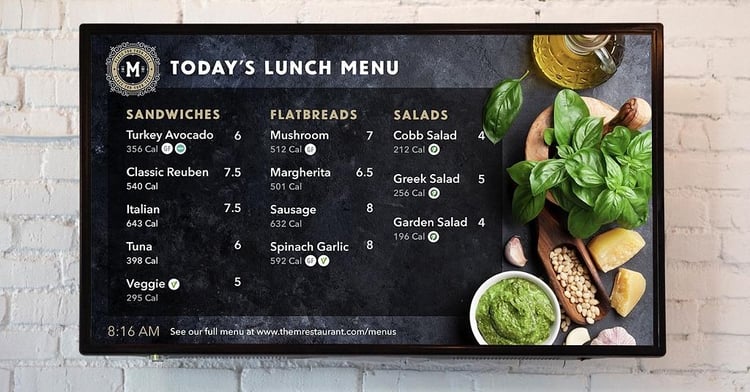When you’re looking for digital signage solutions for your foodservice program, you know it’s important to choose software that provides you, the operator, a great experience. It should be relatively easy for you to get your menu screens up and running, and maintain them with minimal effort.
But what about the other side of your organization? What about your customers and their experiences with your signage?
Since your customers will see and interact with your signs at a far higher rate than you will, their needs should be considered when creating your digital signage. And your signage should be a part of a robust Customer Experience platform to help make this happen.
Here’s why...
The importance of a good Customer Experience platform
You do a lot to provide your customers with a great experience. You make sure your space is laid out for efficient flow and ease of access by customers. You place silverware, napkins, and straws in just the right locations. You make it easy for them to order ahead and pick up their food.
All of these things -- and more -- impact the customer experience. The people who choose to eat with you will feel and think a certain way about your organization as they’re exposed to your brand, products, and people. And they’ll continue to buy from you, or not, based on these experiences.
This is why it’s so important to not only have attractive, readable digital menus, but also to make sure those menus are accurate and updated. A solid Customer Experience platform will help you consistently provide better encounters with your guests, all while making your operator experience delightful, too.
The drawbacks of digital signage point solutions on the customer experience
Now here’s the rub: not all point solutions for digital signage have a robust Customer Experience platform to help you consistently go above and beyond for your customers, without putting more strain on you or your staff.
Some technology might promise a restaurant-quality customer experience on the front end, but is a burden to design on the backend. You might be stuck with an outdated-looking layout that doesn’t integrate well with your food database, for example, and in order to change this, you have to pay for costly development work from your vendor.
Other software vendors might provide pieces of a Customer Service platform, but don’t go far enough to build a foundation to make this experience holistic and consistent within your organization.
For example, while this technology may let you integrate with your food database, you still can’t easily edit your menu data, or assign changes immediately across all your screens, or show allergen information properly -- all of these would contribute to a more customer-friendly display, and therefore a better customer experience.
You can’t provide a good customer experience if your hands are tied due to the limitations of your point solutions, applications, and/or digital signage software. And the reality is that much of this technology is created for commercial foodservice needs, not for the needs of those in the non-commercial space.

The key elements of a great Customer Experience platform
As you can see, your digital signage software must also be a quality Customer Experience platform in order to deliver the best moments to your guests while making your operator experience enjoyable and easy to manage.
So what should you be looking for as you consider digital signage solutions that also boast a Customer Experience platform? Software with these features is a good place to start:
- Built for non-commercial foodservice. The best digital signage software will be built for your needs. If you’re commercial, then your software should be built that way; however, non-commercial signage isn’t best for everyone. For example, you need signage software that supports any cycle menus you have, and lets you display allergen information. The more attuned to your workflow needs, the more likely this software will generate a positive customer experience with your operation.
- Has tools for managing your menu data the right way. As an operator, you should have full control over how, when, and where your menu data appears across all your screens. Look for software that allows you to update and customize your food and menu data, and apply these changes immediately in order to display the most accurate information possible to your customers.
- Lets you edit displays the way you want. Don’t get stuck with rigid templates and designs that don’t work for your customers. You should have full control over your screens’ designs, and you shouldn’t have to rely on someone else to make these changes for you (especially when that ends up taking longer and costing more than you expected).
The immediate and long-term benefits of a quality Customer Experience platform are undeniable. In fact, the foodservice team at University of Colorado Boulder learned first-hand the value of a robust digital signage solution that included a Customer Experience platform.
With this solution, the team was able to offer online ordering, provide real-time updates, customize front-end menus, and more, ultimately creating a more enjoyable, modern customer experience for university staff and students.
